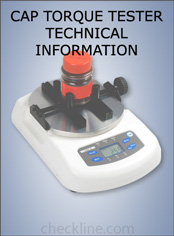1.0 SCOPE
1.1 This is a method for measuring application, removal, and stripping torques for threaded closures on plastic bottles.
2.0 SUMMARY OF METHOD
2.1 Closures are screwed onto the plastic bottle neck finishes or threads finger tight. Capped bottle is then placed in a torque meter or torquing device, and the bottle or closure is rotated to a certain reading and then released.
2.2 Removal torque is done in reverse.
2.3 Stripping torque is determined by torquing closures to the highest reading where stripping occurs.
3.0 SIGNIGICANCE
3.1 Consistent measurements and control of torque is required to assure proper closure tightness. The seal must be positive so that the contents cannot leak and outside substances cannot enter the bottle unless venting closures are used. The user must be able to break the seal easily and reclose the bottle a number of times as needed.
3.1.1 Application torque is a measure of seal tightness. Bottles may be capped using this method in preparation for subsequent testing such as leak tests, drop tests, compression tests.
3.1.2 Tightness of closures as applied by automatic closure equipment is a function of factors other than torque applied such as equipment head pressure, operating cycle, bottle finish dimensions, closure liners, etc.
3.1.3 Removal torque is a measure of application
torque. A new correlation of removal and
application torque must be determined for
each bottle-closure combination. This can be
done following the procedures of this test
method. With this correlation, removal torque
can be used to guide the torque adjustment
of automatic closure equipment. Remember,
erroneous torque readings will mislead the
filler causing him to make improper
adjustment of the capper.
Removal torque of stored and aged bottles
will be affected by factors such as closure
liner compression, strain release of neck or
closure plastic, top loading of bottles, length,
and condition of storage. Removal torque of
aged bottles may not give a good measure
of original closure tightness.
3.1.4 Stripping torque is a measure of bottle neck and/or closure strength.
4.0 DEFINITION
4.1 Torque is the tendency of a force to produce
rotation. It is defined as the product of the
force and the perpendicular distance from its
line of action to the instantaneous axis of
rotation.
Note 1: Good sealing is dependent upon
compressive force between closure
seal system and bottle sealing
surface. Friction due to a tight fit
between closure and bottle may
produce a number that could be
meaningless.
4.2 Closure torque can be related to three measurements.
4.2.1 Application torque-the torque used to apply a closure to effect a peal.
4.2.2 Removal torque-the maximum torque required to remove a closure.
4.2.3 Stripping torque-the torque necessary to strip or override threads while applying a closure.
5.0 APPARATUS
5.1 A spring machine or wrench calibrated to measure torque.
5.2 A bottle holding device.
Note 2: See materials and apparatus list for
the above.
6.0 TEST SPECIMENS
6.1 Bottles and closures are the test specimens.
At least ten new unused bottles and unused
closures selected at random are required for
determining application and removal torque.
Ten additional new unused specimens are
required for determining stripping torque.
Note 3: Spillage of product, oil, water, etc. on
the threads of the bottle or closure, either
intentionally or accidentally, can cause a
misreading of application, removal and
stripping torques. This should be avoided.
6.2 Bottles and closures must be conditioned at least 24 hours at 23° ± 2°C. (73.4 t 3°F).
Note 4: Test specimens for removal torque may be prepared following the application torque procedure.
7.0 PROCEDURE
7.1.1 Application torque.
7.1.2 Apply a closure to each container finger tight
by hand. Position the bottle in the restraining
grippers of the torque tester or
holding jig.
Note 5: Center of neck must be over center
line of torque tester. Bottles with offset necks
must be offset.
7.1.2 A set of test specimens should be used on once.
7.1.3 Torque the closures by increasing the torque gradually and smoothly to a selected level and hold for 5 seconds.
7.14 Record the torque applied to each of the closures on the bottles.
7.2 Removal torque.
7.2.1 Removal torque is determined by removing the closures from the test specimens.
7.2.2 Position each test specimens in the restraining grippers of the torque tester or holding jig. Remove the closures, increasing the removal torque gradually and smoothly until the maximum reading is attained.
7.2.3 Record the maximum torque required to loosen the closure for each of the test specimens and elapsed time between application and removal torque.
7.3 Stripping torque.
7.3.1 Apply a closure to each container by hand. Position the bottle in the restraining grippers of the torque tester or holding jig.
7.3.2 Torque the closure by increasing the torque gradually and smoothly until stripping occurs.
7.3.3 Record the stripping torque level obtained on each of the test specimens.
8.0 REPORT
8.1 Report shall include:
8.1.1 Identification of bottles and bottle closures tested including size, style, material or materials, and any other pertinent information. Bottle finish and closure dimensions should also be reported if applicable.
8.1.2 Record all readings of application, removal, and stripping torque if applicable.
8.1.3 Number of specimens tested.
8.1.4 Conditioning.
8.1.5 Date of test.
8.1.6 Average, range, and standard deviation of values for removal and stripping torques.
8.1.7 Time interval between measurement.
Source: The Society of the Plastics Industry, Inc.

